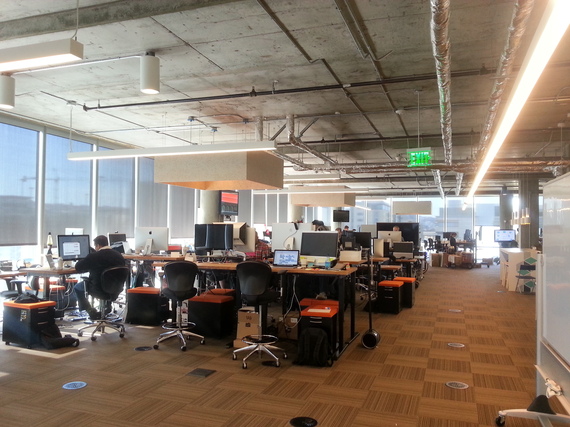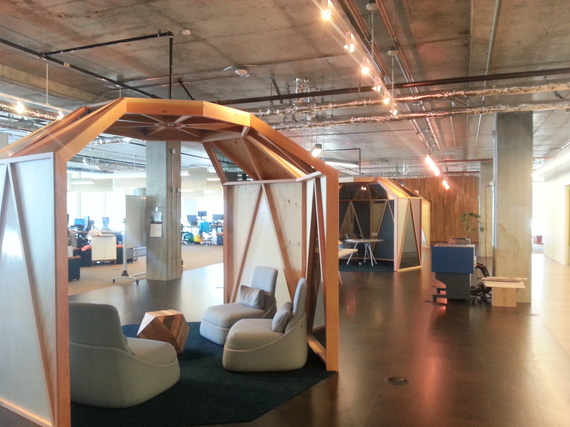Cisco is an old brand born during the Internet's infancy. The company has had a direct hand in what we take for granted, a readily available always-on connection to data and people anywhere in the world.
Typical of 20th century technology companies, as the company grew its meritocratic collaborative start-up culture evolved into one defined by hierarchy, structure, processes and procedures. A visit to their old corporate offices in San Jose, California tells of a cultural history similar to other tech giants of that era. A sea of management offices surrounded by rows of cubes whose occupants are determined by their relationship to the epicenters of power.
All that structure creates cultural baggage and it's stifling. Millennials and Gen Y-ers balk at it, rejecting employment offers where the culture, work environment and social values don't match their needs.
To overcome these hurdles and to break down organizational silos and collaboration barriers that traditional office structures have created, companies have turned to the "open office plan". You've seen them. You get off the elevator to a room filled with rows of tables.
Typical office buildings are not acoustically designed to deal with the noise level of open work environments. They amplify the noise which makes having a productive or even a semi-private conversation virtually impossible. Companies are recognizing that attracting and keeping employees requires more than just tearing out the cubes.
Cisco realized that whitewashing their culture in order to attract the best and brightest wasn't going to work. They had to deliver on the talk of "collaboration drives culture" and approach the problem differently. Their vision is to transform their workplace to "drive employee attraction, retention, productivity and a perpetual collision of creativity," according to Alan McGinty, Senior Director, Global Workplace Solutions Group.
In San Francisco's redeveloped Mission Bay, and around the world, Cisco established one of its Innovation Centers to house its development teams. To meet the needs and expectations of the target workforce, the company invited employees in to have a voice and vote in the design of the workplace.
What Cisco's office designers heard was workers wanted environments that matched their lifestyle and ways that they work. The company, in turn, wanted to put the 'human' back into the work relationship so employees could produce their best results, on their own terms.
- Highly mobile -employees that "travel extensively to customer and partner locations; frequently interacts with customers"
- Campus mobile - "internally mobile; interacts cross-functionally in face-to-face scheduled meetings; often in leadership roles"
- Remote/Distant collaborator - "Non-mobile employee who works frequently with remote colleagues, and frequently works from home"
- Neighborhood collaborator - "Neighborhood-based employee who is mobile within the group area; interacts with, coordinates and manages teams"
- Workstation bound - "Desk-bound, non-mobile employee who performs highly focused individual work; some team interaction"
Cisco defined three objectives for their new culture: Provide different solutions to meet the needs of all types of work, teams and environments; utilize the company's own collaborative technology; and have policies that support workers to work where and when they want to fit their lifestyles. Local teams of employees are accountable for the health and happiness of their neighborhoods and ensure each employee has an environment that is right for them. This collective approach to management is all about choice and making sure that everyone has "more skin in the game."

The result is an open environment that is a real life laboratory for product development, innovation R&D and cultural transformation. The multi-height desks are on wheels and unassigned which teams configure into their own work spaces. The proliferation of Cisco's own video collaboration monitors throughout the building encourages geographically dispersed teams to organize their space in ways that improve spontaneity, collaboration and discussion. White boards abound as does natural light with open, expansive spaces dotted here and there with discussion pits. While the work space looks expensive, I was assured the desks and sofas are from IKEA.
In place of HR and Facilities is a sophisticated change management program that helps people of all generations transition into these new work spaces. The traditional "this is your desk, make the best of it" is replaced with a gradual easing in of employees to these new work models. Given the opportunity to have a voice and vote in their work environments, Cisco found people more rapidly adjust their behavior and modify their work behaviors. According to McGinty, "employees like the energy and the buzz... as well as access to the private spaces they need to do their job. It's about training, new work place etiquette, and change management."
What struck me was the absence of the every present, nerve-grating background noise that is so prevalent in open work environments. The silence wasn't from no one being in the building, there were several hundred people at work.
The space designers created some innovative approaches to provide workers with meeting places that both buffer the sound and provide some privacy in addition to conference and hoteling rooms. The culture the employees formed in the Innovation Lab discourages loud phone discussions or meetings at your desk. Want to talk or know you're loud on the phone; take it someplace else.
The environment has been so successful that it is being implemented in Cisco's headquarters and rolled out globally. The expectation is this will help Cisco transform its culture. While Cisco's initial focus was to build a culture and work environment attractive to Gen Y and Millennials, what they've created is being welcomed by all generations.
The reason Cisco's new culture is successful is because everyone is involved in building a sustainable and environmentally-aware organization. How many companies can point to hard evidence that 25 percent of their energy comes from renewable resources, a 40 percent reduction in CHG emissions, 40 percent reduction in air travel and an over 50 percent reduction in electricity consumption per employee while at the same time achieving over 80 percent increase in employee communication? Not many.
This isn't a bunch of touchy-feely stuff; the ROI is very real. The average charge-back per employee has dropped from $5,162 to $2,596 per year. The savings come in part from a 50 percent annual reduction in cable, IT and furniture CAPEX; and a 30 percent reduction in space requirements. On a global level that equates to fitting 35 percent more people into existing space.
The most telling measure of Cisco's new culture is the 80 percent increase in employee satisfaction.

